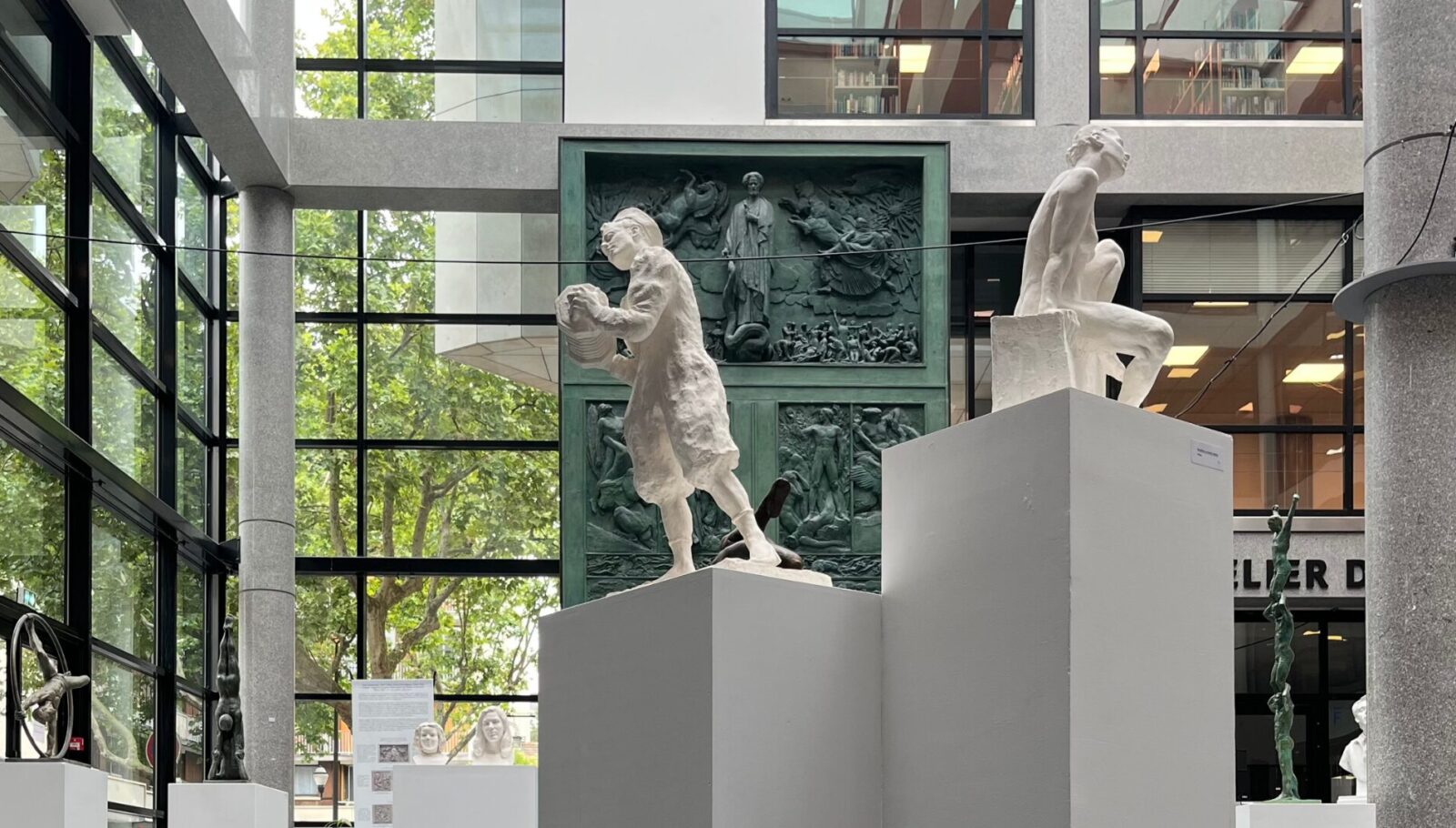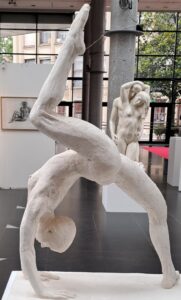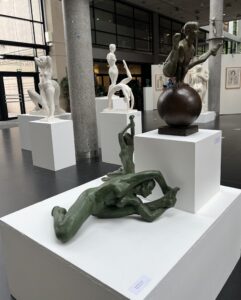A Stationary Arch

The city of Boulogne-Billancourt has given the sculptor Philippe Arnault, former resident of Casa Velazquez in Madrid and recipient of the David Weill award for drawing, the vast reception hall of the Espace Landowski to present a hundred sculptures and several dozen drawings and paintings. A versatile artist, Philippe Arnault is both a remarkable observer of the human body and a powerful animal sculptor. This major exhibition was conceived as a dialogue between the works and the mediums, the drawings responding to the sculptures with great finesse and acuity.
 For Philippe Arnault, acrobatics, whatever its form, is a powerful allegory of the body in action. Choosing sculpture to represent movement is both a gamble and a challenge, but it also means accepting the risk of taking a new path to express the tension and intensity of each gesture. The circus is an ideal territory to simultaneously explore the vital momentum and the possibility of falling, the power of balance and the fragility of imbalance, and express it through a magnificent still scope. Despite the apparent rigidity of plaster or bronze, through each of Philippe Arnault’s works, there is a palpitating existence. Sculpting, confronting the clay, is a way to halt the process of disappearance, to establish an attitude, a presence. And when one decides to sculpt acrobats, vibrant tenants of an ephemeral art, the principle of capturing a gesture or an attitude to try to fix its vulnerability takes on its full meaning. Each sculpture is a bridge between memory, matter, and form—a way to anchor the present while exploring the attic of memories. Philippe Arnault questions the attitudes of the present as well as those of great figures of the past, and there is something fascinating in this quest for the reconstruction of appearances that sometimes persist from one century to the next. In the same way, from one sculpture to another, it’s a whole world that unfolds from yesterday to today and that continues to richly grow over the successive creations. Because it is indeed a matter, between material and skin, of brushing the texture of traces, of asserting the imprint of gesture and hand, of justifying an action that develops from the initial idea and amplifies up to the first sketch, until the culmination of a long process of construction, the affirmation of a journey that promotes, step by step, the emergence of an artwork.
For Philippe Arnault, acrobatics, whatever its form, is a powerful allegory of the body in action. Choosing sculpture to represent movement is both a gamble and a challenge, but it also means accepting the risk of taking a new path to express the tension and intensity of each gesture. The circus is an ideal territory to simultaneously explore the vital momentum and the possibility of falling, the power of balance and the fragility of imbalance, and express it through a magnificent still scope. Despite the apparent rigidity of plaster or bronze, through each of Philippe Arnault’s works, there is a palpitating existence. Sculpting, confronting the clay, is a way to halt the process of disappearance, to establish an attitude, a presence. And when one decides to sculpt acrobats, vibrant tenants of an ephemeral art, the principle of capturing a gesture or an attitude to try to fix its vulnerability takes on its full meaning. Each sculpture is a bridge between memory, matter, and form—a way to anchor the present while exploring the attic of memories. Philippe Arnault questions the attitudes of the present as well as those of great figures of the past, and there is something fascinating in this quest for the reconstruction of appearances that sometimes persist from one century to the next. In the same way, from one sculpture to another, it’s a whole world that unfolds from yesterday to today and that continues to richly grow over the successive creations. Because it is indeed a matter, between material and skin, of brushing the texture of traces, of asserting the imprint of gesture and hand, of justifying an action that develops from the initial idea and amplifies up to the first sketch, until the culmination of a long process of construction, the affirmation of a journey that promotes, step by step, the emergence of an artwork.
By approaching the animal world, the sculptor has opened up an immense field of play and exploration. From a few debonair bears to a haughty giraffe, from a donkey with long curly hair to an equilibrist elephant, from a patient rhinoceros to fiery cats, the menagerie of Philippe Arnault is singular. It is almost a new gallery of portraits, captured on the spot and translated into bronze, plaster or earth. The animal sculpture is a particular exercise that relies on both the sense of observation and the mastery of the attitude specific to each of the creatures seized in the immediacy of their presence.But it is also a very intuitive gesture—a way of capturing the animal’s personality through both spirit and material, whether wild or familiar. Goliath, the giraffe of the Moreno circus, Gus, the rhinoceros of the Vincennes zoological park, Toffy and Piccolo, the two elephants of the Grüss circus, all these beasts have an identity and a character, a bit like unforeseen actors, chosen by the sculptor and becoming, thanks to him, stars for eternity. Over the seasons, for a few decades, it is a whole bestiary that has patiently developed, multiplying postures to embody a single animal or seizing it once and for all in the attitude that best signifies it.
 To be an animal sculptor is to be part of a multi-millennial lineage, to draw inspiration from the sources of the representation of the world. It is finding the path of origins—when, with a few pigments and a gift for modeling fierce creatures and deer onto cave walls, humans managed to capture the very essence of their existence. The initial material, a bit of wet earth, is the physical link between the imaginary and the reality of the sculpture. All these animals, reflections of a living nature, resemble witnesses. They are the fruit of a desire and an intuition, the tactile implementation of fascinating creatures, sometimes escaped from distant lands, sometimes seized at the bend of a country road. It is an intuitive menagerie, the tangible translation of all that nature has in what is most beautiful, most powerful, and sometimes most fragile, to offer us from one side of the world to the other.
To be an animal sculptor is to be part of a multi-millennial lineage, to draw inspiration from the sources of the representation of the world. It is finding the path of origins—when, with a few pigments and a gift for modeling fierce creatures and deer onto cave walls, humans managed to capture the very essence of their existence. The initial material, a bit of wet earth, is the physical link between the imaginary and the reality of the sculpture. All these animals, reflections of a living nature, resemble witnesses. They are the fruit of a desire and an intuition, the tactile implementation of fascinating creatures, sometimes escaped from distant lands, sometimes seized at the bend of a country road. It is an intuitive menagerie, the tangible translation of all that nature has in what is most beautiful, most powerful, and sometimes most fragile, to offer us from one side of the world to the other.
Philippe Arnault is a tightrope walker of creation. Day after day, for several decades, he has ventured on the wire of creation, in search of an always fragile balance between inspiration and accomplishment. Motivated by the ever-changing experience of his daily work, he seizes a bit of clay or wax, with one single idea in mind, to give life to a new creature, infuse the vital impulse into an unprecedented silhouette, shape the material to make it, after long hours of work, a work of art. At the first moment, when the hands, guided by imagination and inspiration, touch the clay, much more than a decision to make, it is indeed an impulse that is involved. As such, for a sculptor, choosing the circus is decisive. Philippe Arnault spends long hours on the edge of the circus ring to draw, feel and immerse himself in the gallop of horses, the strength of acrobats, the virtuosity of jugglers.
The circus induces another perception of the body in action, whether human or animal. This is where all the strength of Philippe Arnault’s creative process lies: to consider each of his models, from the most humble to the most famous, as an architecture of meaning and tension, but also and above all as an ephemeral partner that must be understood at the same time, seduced, and, to a certain extent, conquered. Because there is something that pertains to the most absolute commitment in the accomplishment of each of the steps that will lead the hand and mind of the sculptor to seize the allure and psychology of his subject. Over the years, an amazing stationary arch has wisely taken place on the workshop shelves, a revisited carnival of animals that offers itself as a counterpoint to busts, great nudes and acrobats. The entire repertoire of Philippe Arnault is there, from flexible contortionists to powerful equilibrists, from roaring felines to prancing horses, each work is an elegant or powerful rebirth of the subject it represents. These assembled sculptures, between inventory and repertoire of forms, affirm the continuity of a work that continues to reinvent itself through a pact with matter. More than a retrospective, strong in all its facets, this exhibition is a self-portrait.
All images: Courtesy of Pascal Jacob
Editor's Note: At StageLync, an international platform for the performing arts, we celebrate the diversity of our writers' backgrounds. We recognize and support their choice to use either American or British English in their articles, respecting their individual preferences and origins. This policy allows us to embrace a wide range of linguistic expressions, enriching our content and reflecting the global nature of our community.
🎧 Join us on the StageLync Podcast for inspiring stories from the world of performing arts! Tune in to hear from the creative minds who bring magic to life, both onstage and behind the scenes. 🎙️ 👉 Listen now!
